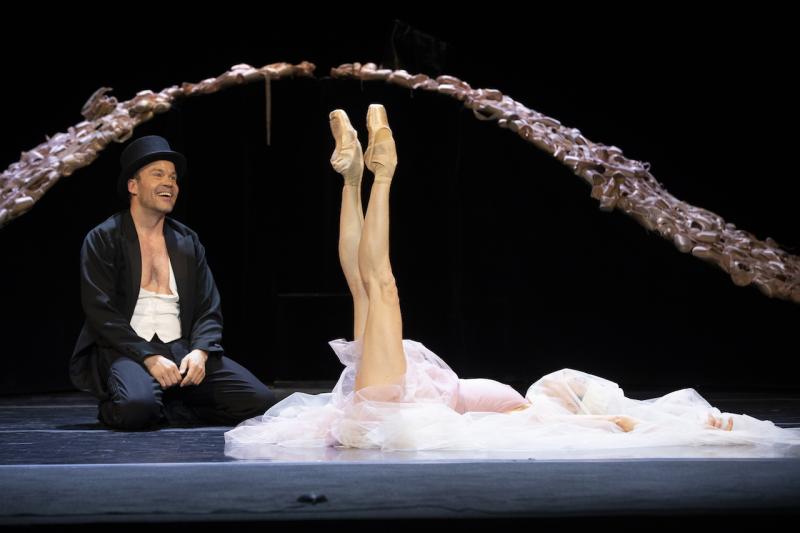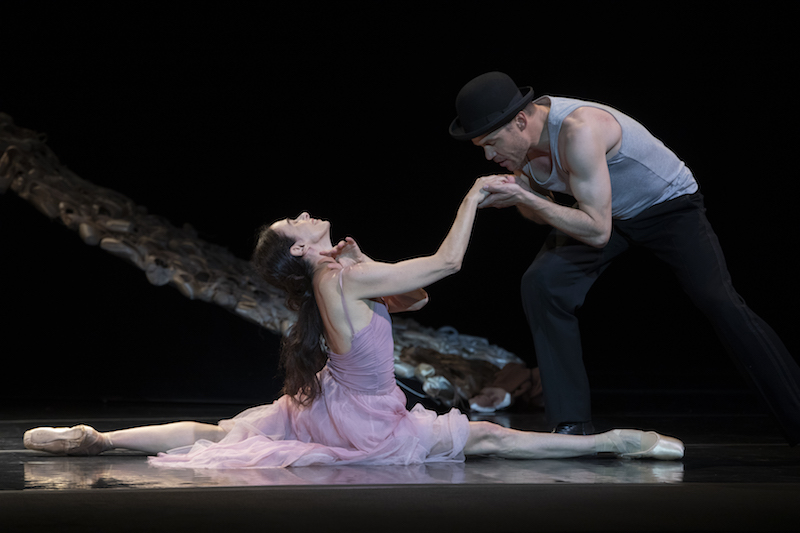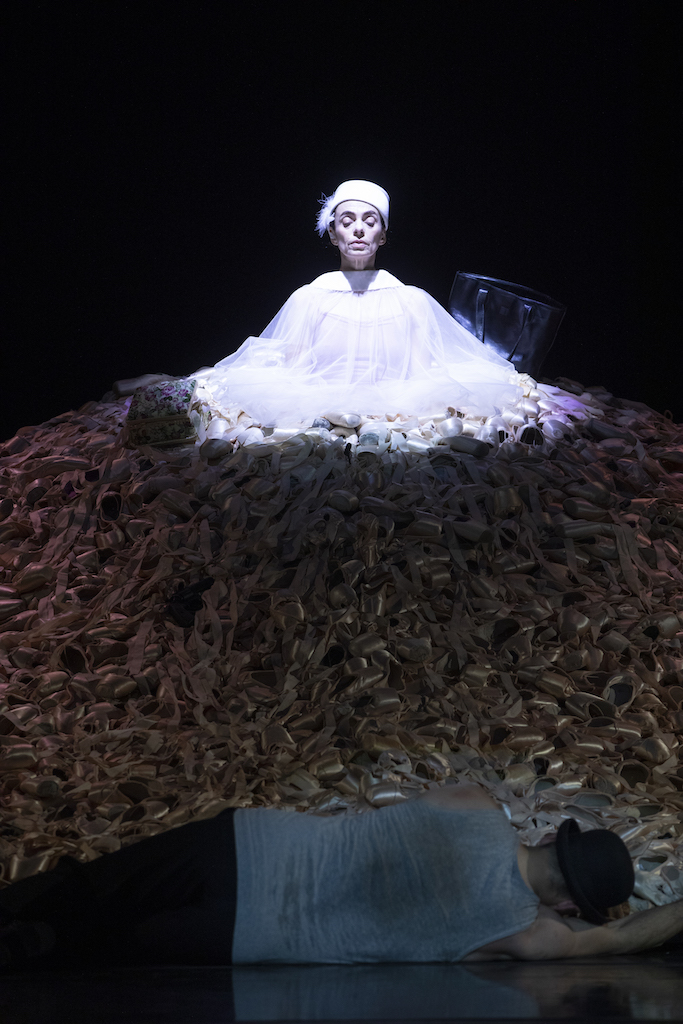L'Heure Exquise, Linbury Theatre review - an exquisite tragedy in miniature | reviews, news & interviews
L'Heure Exquise, Linbury Theatre review - an exquisite tragedy in miniature
L'Heure Exquise, Linbury Theatre review - an exquisite tragedy in miniature
Alessandra Ferri marks her 40 years in ballet with a remarkable solo turn

Ballet dancers, even the greatest, don’t expect longevity. There are no Maggie Smiths or Helen Mirrens in the ballet world – there just aren’t the roles. So the news that Alessandra Ferri was to mark the 40th anniversary of her association with the Royal Ballet (she joined aged 17) with a run of performances of a one-woman show was of more than passing interest.
The 70-minute piece is an adaptation of Samuel Beckett’s play Happy Days, in which a woman called Winnie recounts the routines of her humdrum life while buried up to the waist, later up to the neck, in sand. Her husband Willie is often out of sight and mainly silent. In Béjart’s version, the mound comprises a couple of thousand used satin pointe shoes. This doesn’t even begin to represent the number of pairs a ballerina gets through in the course of a career.
 Béjart is faithful to his source in many respects, but as this is dance, his Winnie is soon released from her pale pink shoe-prison to express her recollections in movement. First, though, we are reminded of an inescapable chore that becomes second nature to dancers: the prepping of new shoes and the attaching of ribbons. Ferri chats to us easily as she sews. She would have liked to be an actress, she confides, “but I am a ballerina. And I can move most of the time without being in pain.”
Béjart is faithful to his source in many respects, but as this is dance, his Winnie is soon released from her pale pink shoe-prison to express her recollections in movement. First, though, we are reminded of an inescapable chore that becomes second nature to dancers: the prepping of new shoes and the attaching of ribbons. Ferri chats to us easily as she sews. She would have liked to be an actress, she confides, “but I am a ballerina. And I can move most of the time without being in pain.”
Easing her feet into the shiny new pointes and tying them on, she strips down to a rehearsal tunic and launches into a personal warm-up, lying on her back and stretching her immaculately pointed feet and long, still beautiful shapely legs. It’s at this point that Ferri is joined by bowler-hatted Carsten Jung (pictured above with Ferri), whose character, unlike the original Winnie’s largely absent husband, appears to dote on her, resting his chin goofily on the soles of her flexed feet the better to gaze into her face, or following her on all fours like a dog. But increasingly, as Ferri chatters on, you suspect this tireless admirer to be a mirage, the product of an ex-ballerina’s fantasy, along with the class and rehearsal she is hurrying to be ready for, and the audience whose imagined cheers she receives with a mixture of blushes and pride.
 In the second half, instead of being buried up to her neck like Winnie, Ferri wears a romantic gauze tutu around her neck, veiling her almost to her feet like one of the Wilis in Giselle. She duly sketches for us a few signature Romantic steps and gestures and revisits her rippling Swan Queen arms. In an eclectic mix of dance styles, to recorded music by Webern, Mahler, Mozart, there is even a nod to Fred Astaire and Ginger Rogers. These are fragments, unconnected glimpses of a life, but Ferri brings such convincing emotional substance to the subtly damaged creature she presents to us that we ourselves are able to join the dots.
In the second half, instead of being buried up to her neck like Winnie, Ferri wears a romantic gauze tutu around her neck, veiling her almost to her feet like one of the Wilis in Giselle. She duly sketches for us a few signature Romantic steps and gestures and revisits her rippling Swan Queen arms. In an eclectic mix of dance styles, to recorded music by Webern, Mahler, Mozart, there is even a nod to Fred Astaire and Ginger Rogers. These are fragments, unconnected glimpses of a life, but Ferri brings such convincing emotional substance to the subtly damaged creature she presents to us that we ourselves are able to join the dots.
It’s hard to imagine any other great dance-actress of recent years pulling this off. Sylvie Guillem? Tamara Rojo? Neither is sufficiently thin-skinned. With Ferri, even at her most girlish and laughing, there is a fear she might crumple at any moment. It's a very special gift. Ferri's jolie-laide beauty also makes her uniquely compelling. That face, forever mobile, an unusual mixture of strong bones and snub features, carries a fluctuating threat of tipping into despair. Anyone unfamiliar with Ferri's work as a ballerina of international stature should check out her Giselle, easy to find on YouTube, to see that fragile strength in action. Or catch this. It's a miniature, for sure, but it punches above its weight.
rating
Explore topics
Share this article
The future of Arts Journalism
You can stop theartsdesk.com closing!
We urgently need financing to survive. Our fundraising drive has thus far raised £49,000 but we need to reach £100,000 or we will be forced to close. Please contribute here: https://gofund.me/c3f6033d
And if you can forward this information to anyone who might assist, we’d be grateful.

Subscribe to theartsdesk.com
Thank you for continuing to read our work on theartsdesk.com. For unlimited access to every article in its entirety, including our archive of more than 15,000 pieces, we're asking for £5 per month or £40 per year. We feel it's a very good deal, and hope you do too.
To take a subscription now simply click here.
And if you're looking for that extra gift for a friend or family member, why not treat them to a theartsdesk.com gift subscription?
more Dance
 'We are bowled over!' Thank you for your messages of love and support
Much-appreciated words of commendation from readers and the cultural community
'We are bowled over!' Thank you for your messages of love and support
Much-appreciated words of commendation from readers and the cultural community
 Peaky Blinders: The Redemption of Thomas Shelby, Rambert, Sadler's Wells review - exciting dancing, if you can see it
Six TV series reduced to 100 minutes' dance time doesn't quite compute
Peaky Blinders: The Redemption of Thomas Shelby, Rambert, Sadler's Wells review - exciting dancing, if you can see it
Six TV series reduced to 100 minutes' dance time doesn't quite compute
 Giselle, National Ballet of Japan review - return of a classic, refreshed and impeccably danced
First visit by Miyako Yoshida's company leaves you wanting more
Giselle, National Ballet of Japan review - return of a classic, refreshed and impeccably danced
First visit by Miyako Yoshida's company leaves you wanting more
 Quadrophenia, Sadler's Wells review - missed opportunity to give new stage life to a Who classic
The brilliant cast need a tighter score and a stronger narrative
Quadrophenia, Sadler's Wells review - missed opportunity to give new stage life to a Who classic
The brilliant cast need a tighter score and a stronger narrative
 The Midnight Bell, Sadler's Wells review - a first reprise for one of Matthew Bourne's most compelling shows to date
The after-hours lives of the sad and lonely are drawn with compassion, originality and skill
The Midnight Bell, Sadler's Wells review - a first reprise for one of Matthew Bourne's most compelling shows to date
The after-hours lives of the sad and lonely are drawn with compassion, originality and skill
 Ballet to Broadway: Wheeldon Works, Royal Ballet review - the impressive range and reach of Christopher Wheeldon's craft
The title says it: as dancemaker, as creative magnet, the man clearly works his socks off
Ballet to Broadway: Wheeldon Works, Royal Ballet review - the impressive range and reach of Christopher Wheeldon's craft
The title says it: as dancemaker, as creative magnet, the man clearly works his socks off
 The Forsythe Programme, English National Ballet review - brains, beauty and bravura
Once again the veteran choreographer and maverick William Forsythe raises ENB's game
The Forsythe Programme, English National Ballet review - brains, beauty and bravura
Once again the veteran choreographer and maverick William Forsythe raises ENB's game
 Sad Book, Hackney Empire review - What we feel, what we show, and the many ways we deal with sadness
A book about navigating grief feeds into unusual and compelling dance theatre
Sad Book, Hackney Empire review - What we feel, what we show, and the many ways we deal with sadness
A book about navigating grief feeds into unusual and compelling dance theatre
 Balanchine: Three Signature Works, Royal Ballet review - exuberant, joyful, exhilarating
A triumphant triple bill
Balanchine: Three Signature Works, Royal Ballet review - exuberant, joyful, exhilarating
A triumphant triple bill
 Romeo and Juliet, Royal Ballet review - Shakespeare without the words, with music to die for
Kenneth MacMillan's first and best-loved masterpiece turns 60
Romeo and Juliet, Royal Ballet review - Shakespeare without the words, with music to die for
Kenneth MacMillan's first and best-loved masterpiece turns 60
 Help to give theartsdesk a future!
Support our GoFundMe appeal
Help to give theartsdesk a future!
Support our GoFundMe appeal

Add comment